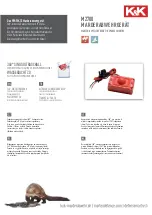
BRONKHORST®
9.17.061
EL-FLOW
Base
Series Mass Flow Controllers
Page 9
1.7 Operating Principles
1.7.1 Thermal Gas Flow Sensor Principle
The gas flow sensor operates on a principle of heat transfer by sensing the temperature difference along
a heated section of a capillary tube. Part of the total flow is forced through the capillary by means of a
laminar flow element in the main stream generating a pressure difference.
The design of the laminar flow device is such that flow conditions in both the capillary and laminar flow
device are comparable, thereby resulting in proportional flow rates through the meter. The delta-T
sensed by the upstream and downstream temperature sensors on the capillary depends on the amount
of heat absorbed by the gas flow.
The transfer function between gas mass flow and signal can be described by the equation:
m
p
signal
c
K
V
V
signal
= output signal
c
p
= specific heat
K = constant factor
m
= mass flow
Thermal sensor in a bridge configuration
The temperature sensors are part of a bridge circuit. The imbalance is linearised and amplified to the
desired signal level.
1.7.2 Bypass Principle
The measurement part of an EL-FLOW
Base
consists of a thermal sensor and a laminar flow element
(LFE). A laminar flow element consists of a stack of discs with precision etched flow channels. The flow
through each channel is proportional to the flow through the sensor. In this way, by adding more or less
laminar flow discs, the total flow rate of an instrument can be adjusted while using the same sensor flow
rate.
In general instruments with these sensors may be mounted horizontal, as well as in a vertical position, at
low operating pressures.
Sensor flow
10 mln/min Air
LFE(4x) flow
10 mln/min Air
10 mln/min Air
10 mln/min Air
10 mln/min Air
Example of a 50 ml
n
/min measurement part
V
s
i
g
n
a
l










































